Botswana’s Dust
Jacquelyn Gleisner
April 2016
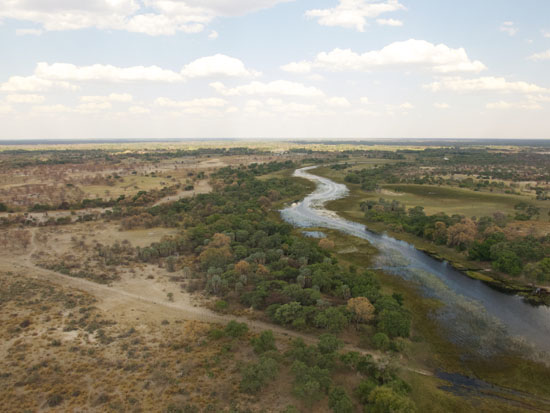 View from the Helicopter over the Okavango Delta, Botswana
View from the Helicopter over the Okavango Delta, Botswana
I’m in a helicopter. Below me, the mouth of the Okavango Delta in Maun, Botswana. I see two giraffes, their tall silhouettes blending into the trees. A zeal of zebras emerges from the grass. Then hippos, elephants, and a field full of wildebeests come into view. Dust clouds follow the frantic hooves of a wildebeest running from the herd. Finally, I see three gray baboons moving slowly into the shade.
The week before, I was in Gaborone with two other American artists, Peter Clouse and Jill Galarneau, standing inside the dining room of Earl R. Miller, US Ambassador to the Republic of Botswana, where one of my paintings had been installed. A handful of other artists also have works at the Ambassador’s residence, but the three of us had been invited to travel to Botswana for a particular reason. Together, we learned that we had been chosen for this artist exchange because of the materials we used in our works. My painting was made on paper.
I started working on paper when I was stuck. I wasn’t creating much artwork, so I decided to spend less money on my materials. I eventually gave up my studio in Brooklyn when being there felt difficult, and the dust bunnies in the space had become more prolific than I was. Without a studio space, I started painting on paper, so I could move through ideas quickly while I figured things out.
Part of the problem was that I had started to believe that writing was the highest and purest form of art. As a visual artist, I think in images, and while I believe it’s important to communicate to others in this way, I sometimes feel conflicted about producing more clutter on this earth or taking up too much space. Old papers can be tossed into a bonfire and I can roll my works on paper into small tubes, whereas my paintings on canvas and other supports feel burdensome. Canvases and wooden panels, rigid and cumbersome supports, gather dust in my studio. Paper, by contrast, is weightless. Marks on paper are fresh and immediate like the words of an author on a page. Working on paper has helped me forge a bridge between the visual arts and writing.
People and paper are both strong yet fragile. Paper is easily damaged, but it is resilient; it can be torn, shredded, and pulverized back into itself. Likewise, a person is constantly recycling snippets of old experiences and memories into their newer self. I get an itch to cut my hair short about every four years, a ritual that connects former selves in appearance and a cyclical need to shed the weight of the past. In a similar fashion, abandoned ideas emerge in new works years later.
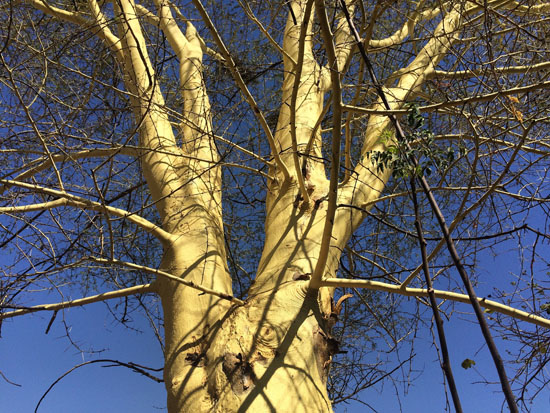 Fever Tree, Maun, Botswana
Fever Tree, Maun, Botswana
In Botswana, the subject of money arose often. Batswana artists were curious how much money I make from my art and many were shocked to learn that I work other jobs to support myself. They also wanted to know how they could make more money from the sales of their art, not because they were greedy—my students in America have the same concerns—but because all artists want to know how to sustain a successful career. Everyone—not just artists—wants to know how passion can become a paycheck, how work can feel like anything but work.
I empathize with this desire, but I am also frustrated by these conversations. Success is personal; it’s not always determined by profit. But these talks about the professionalization of the arts are often stuck on this topic. Needless to say, there are more lucrative and stable paths if money and comfort are the goal. A career as an artist is highly individual. The space that you can occupy within the art world results from your unique interests, skills, and efforts. General instructions for hacking a career as an artist do not exist. The best place to start is by knowing yourself.
I know that I’m wary of positioning myself as an entrepreneur, hawking my paintings as something to be consumed or owned. I don’t like owning things, so it feels alien to me to make a business of making things for others to own. Possessions accumulate physical and emotional grime over time. I love seeing art in museums and public spaces, but I have not collected much art for myself. I can’t afford the works that I desire most, and I also don’t like owning expensive things. And while I love the physical act of painting and drawing, I have a hard time imagining that I could earn a comfortable wage as a full-time painter that would not also involve restrictions on my freedom. There can be pressure for artists to reproduce popular and sellable styles or works, even when the artist has moved beyond those ideas. In the art market, the pursuit of capital gains sometimes runs astride from the progression of ideas.
For example, some of the artists I met in Botswana felt beholden to the wants of tourists; I couldn’t count all the paintings of cheetahs I saw. On our last day in Botswana at a presentation with art educators, one of the teachers joked that the bushman who appears in many of the paintings for tourists has not changed in over twenty years. Later I learned that some of the patterns on the baskets I coveted were not native to the area; geometric designs were more popular with tourists than the scenes of daily life that were common among the country’s ancient weavers. These artisans meet the demands of the market and, as a result, uninformed visitors assume a false visual history of the culture. This confusion illustrates not only my naïveté, but also an occasion in which money and art fail to coexist with a culture.
Tellingly, the word for money means blood in Setswana, according to an artist I met in Gaborone. Whereas money is tied to blood in the native language of Botswana, the word for the country’s currency has a much more positive connotation. Pula is an expression that translates to “let there be rain.” Because over seventy percent of Botswana’s land is consumed by the Kalahari Desert, the rain that makes the crops grow and sustains all life is associated with wealth. In the dry season, rain is rare and valuable.
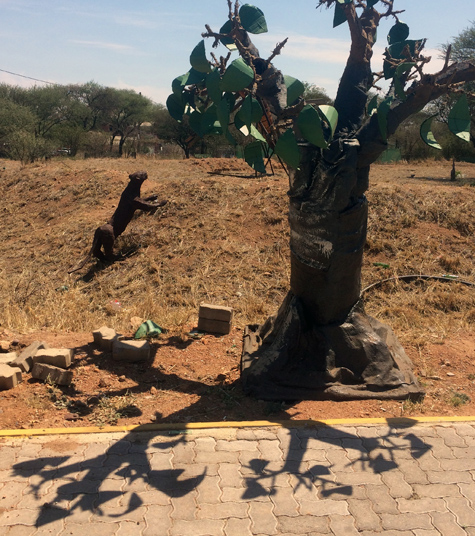 Thapong Visual Arts Centre, Gaborone, Botswana
Thapong Visual Arts Centre, Gaborone, Botswana
I visited Botswana during one of the dry months and the dust of the desert blanketed all surfaces. Only hours after we had landed in Gaborone, Ambassador Miller addressed this phenomenon. He mentioned that one of the artists in the audience at the Thapong Visual Arts Centre had studied in the United States and returned to Gaborone after college. This artist had told Ambassador Miller that he had to come back to Botswana, because he missed the country’s dust. While the dust was at times a nuisance to me, a foreigner, it is what makes that place feel like home to others.
Since that night, I have been thinking about how I could make art that feels like this dust. Because of my inner turmoil over writing versus visual art, I keep trying to imagine a form of visual art that could be immaterial. The transformation of cheap or ordinary materials into an extraordinary work of art feels more powerful than expensive and prized materials morphing into even more exorbitant artworks. After all, what is more beautiful: a thing or the idea of a thing? I wonder what is more imaginative: the painting or the idea of where the painting could travel?
I began thinking about where paintings start and stop when a friend, another artist, told me that in the last moments before sleep, he thought more often about novels and stories rather than paintings, sculptures, or installations. Text crept into his thoughts in a way that art didn’t as he drifted off to sleep. I believe that if the visual arts did not need to live inside specific buildings, bounded by certain physical structures, or in service of select people, then it could go anywhere. Art could be in your bed at night, resting on your pillow, inside your sleepy thoughts.
Certain systems for producing and selling art are exclusive and elitist, but as an artist, I can choose to participate in a broken system or strive to make art that can be translated more readily across social, political, and geographical borders. When money is involved in the right ways—like public funding and institutional support for artists to make, travel, and exhibit their works—artists have a broader ability to express themselves without worrying if the work will sell to a private party for a certain amount of money.
I want to create work that feels meaningful to me in the medium that feels most appropriate. Sometimes I write, other times I paint, and all the while endeavoring to find something novel in between these two forms. For now, I define my success as having this freedom. I know that I want to feel weightless like paper and roam free like Botswana’s dust.
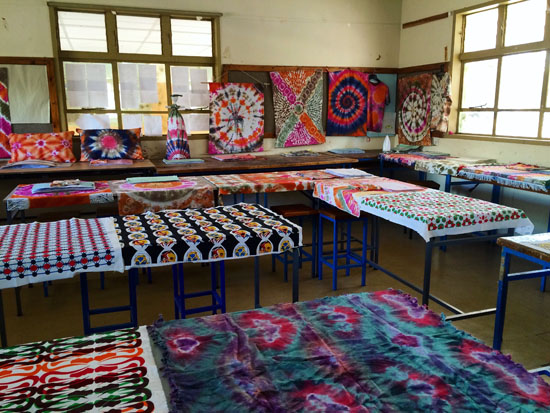 The batik and tie-dye room at the Molepolole College of Education, Molepolole, Botswana
The batik and tie-dye room at the Molepolole College of Education, Molepolole, Botswana
.
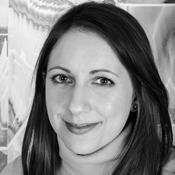
Jacquelyn Gleisner is a visual artist and writer. In October 2015, Jacquelyn traveled to Botswana through the Art in Embassies program, funded by the US State Department.** She currently teaches at Framingham State University and the New Hampshire Institute of Art.
**The views expressed in this essay are those of the author, not the US State Department
